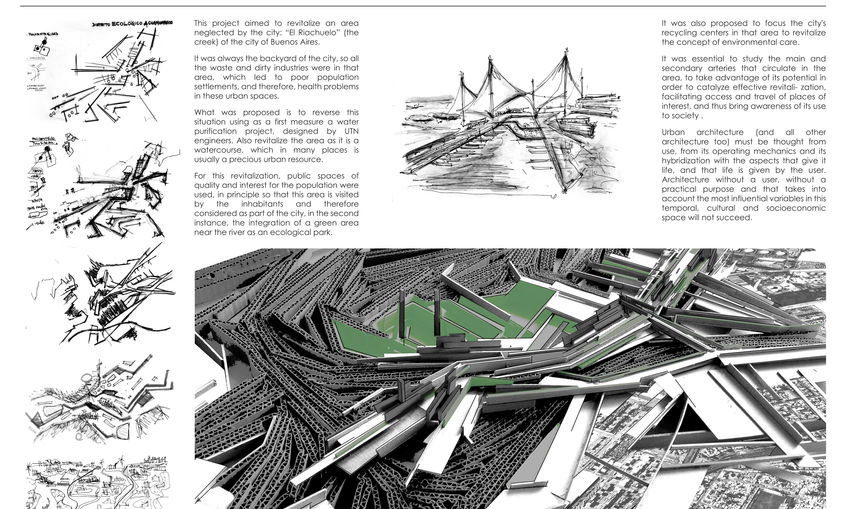

TYPE
Education
YEAR
2015
SERVICES
Design
STAGE
Contest
VALUE
USD ---
RECOVERING
THE RIVER
Reconnecting the Divide: A Comprehensive Urban Plan for Argentina’s Most Populous Area
This visionary project embarks on a profound exploration of Argentina’s most densely inhabited region, an area teeming with the vibrant yet fragmented interactions of its 14,312 inhabitants per square kilometer. By peeling back the layers of its social, economic, and environmental dynamics, the study reveals a city defined as much by its divisions as by its connections. At the heart of this narrative lies a neglected stream—a natural artery that, rather than uniting, has evolved into a chasm separating communities.
LOCATION
Buenos Aires, Argentina
The Stream as a Social and Urban Boundary
The stream, which could embody the lifeblood of the city, has instead become a stark delimiter. It divides the population into disparate social, economic, and environmental strata, a reality shaped by historical policies and unchecked industrial priorities. Over the decades, this space has been dominated by the productive sector, its pursuit of profit eroding opportunities for public enrichment. Laws to mitigate these impacts have been sparse, and the result is a stream that symbolizes neglect rather than unity.
Through a meticulous analysis of historical patterns and present-day realities, the project has unearthed the root causes of this societal fracture. A lack of public spaces, minimal infrastructure to bridge the stream, and a history devoid of cultural or social investment have compounded the issue. The stream, once a potential focal point of connection, has been relegated to the margins of urban life.
A Vision for Transformation
In response, this project proposes a transformative urban plan designed to reimagine the stream as a space of cohesion and opportunity. Central to this vision is the creation of high-quality public spaces, imbued with cultural and social significance, that draw the community back to the water’s edge. The plan integrates the following key elements:
Revitalized Public Spaces: Forgotten areas along the stream will be reborn as hubs of community engagement, featuring public buildings dedicated to social and cultural activities.
Enhanced Connectivity: The addition of new transport arteries and bridges will mend the spatial divide, enabling seamless movement across the stream and fostering unity.
Citizen Participation: Empowering the population to participate in decision-making processes ensures that the spaces reflect the needs and aspirations of those they serve.
Sustainable Development: The transformation incorporates ecological restoration, prioritizing native vegetation and sustainable design to preserve the stream’s natural integrity.
Cultural Integration: Art and cultural programs will breathe life into these spaces, fostering a sense of identity and belonging.
A Holistic Approach
This vision stems from a synthesis of historical analysis, community surveys, and forward-looking projections. It aims to address the pressing challenges of today while laying the foundation for a future where urban spaces prioritize inclusivity, sustainability, and human connection.
The Role of Design in Unity
The project underscores a critical truth: no urban space can achieve its full potential without the active participation of its inhabitants. By involving the community in the process and reshaping neglected areas into vibrant centers of activity, this urban plan aspires to heal the divisions wrought by history. It transforms the stream from a boundary into a shared resource, a testament to the power of design to unify and inspire.
This initiative is a call to action for a city to embrace its potential, forging a path where every inhabitant—present and future—can find their place within the urban fabric. In reconnecting the stream with the people, it redefines not just a space, but a way of living.










